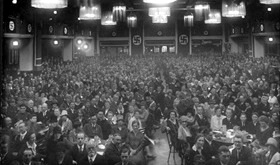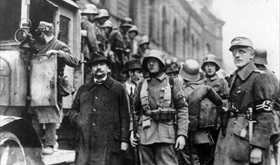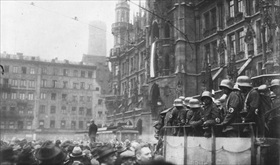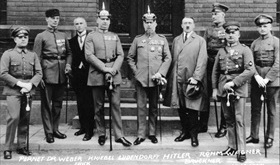HITLER BECOMES GERMAN CITIZEN
Munich, Germany · February 26, 1932
On this date in 1932 in Germany, Austrian-born Adolf Hitler was granted German citizenship. A decade earlier the stateless Austrian (Hitler had formally renounced his Austrian citizenship in April 1925) was the unlikely leader of a fringe Populist-nationalist movement, the National Socialist German Workers’ Party. In November 1923 he led a “beer hall putsch” in the Bavarian capital, Munich, hoping to spur dissatisfied elements in the German Army to topple the 4‑year-old national government in Berlin, the so-called Weimar Republic (see video below). The far-right putsch was immediately suppressed by Bavarian authorities at the cost of more than a dozen Nazis, 1 bystander, and 4 Bavarian policemen (the first of Hitler’s victims) who were killed on the Odeonsplatz, in Munich’s city center. There a cordon of police confronted the marchers, some of whom were armed. The fickleness of fate saved Hitler from possibly being wounded or killed as police bullets tore into his bodyguard and a nearby marcher, killing them and injuring many more. Among the seriously injured was Hitler’s future Luftwaffe chief, Hermann Goering.
Hitler was arrested and sentenced to 5 years in Bavaria’s Landsberg prison for high treason. In a comfortable cell the 36‑year-old convicted terrorist polished his already considerable oratorical skills and dictated his crackpot autobiographical screed, Mein Kampf (My Struggle), to fellow inmate Rudolf Hess. In 2 volumes Hitler laid out a blueprint for his party’s takeover of Germany and the country’s revenge it would take, with special attention directed at German Jews, Social Democrats, and Communists, in the wake of its humiliating defeat in World War I and the burdensome Treaty of Versailles. Not a publishing phenomenon at first, by 1945 the book had sold 10 million copies in Germany alone.
In late December 1924 Bavarian authorities, pressured by Hitler’s supporters, pardoned and released their prisoner early “for good behavior.” Six years later, in 1930, the ex-convict and his National Socialist (Nazi) party had emerged as key players in shaping a coalition government under German President Paul von Hindenburg. The heavily bemedaled World War I hero—a living, wheezing link to Germany’s glory days under Kaiser Wilhelm II—despised “that Bohemian corporal.” (Hindenburg knew of Hitler’s Austrian ancestry but enjoyed using the pejorative adjective “Bohemian” when referencing Hitler.) Hitler’s aptitude, the former Field Marshall said, would consign him at best to being a lowly postmaster general. With newly minted citizenship and the right to hold public office in Germany, Hitler could command a high cabinet post now that voters had elected a plurality of Nazis to the Reichstag (German parliament). Though the Nazis lost seats in November that year, Hindenburg ate his words and appointed the former lance corporal, at age 43, to the second highest office in the land, that of German Chancellor, on January 30, 1933.
Hindenburg had hoped that the moderate members of Hitler’s cabinet, in which Hitler’s National Socialists were a minority, would act as a restraining influence on the powerful new political leader. But within months Hitler had turned tables on the German president. Shortly after the Reichstag building erupted in flames on the night of February 27, 1933, Hitler assumed absolute power through a series of Enabling Acts signed by the doddering Hindenburg. In August 1934 Hindenburg succumbed to old age and Germany’s parliamentary system of representative government (or what was left of it) succumbed, in turn, to Hitler, leaving the Nazi leader at the helm of a nation he steered toward bestial savagery, genocidal war, and apocalyptic ruin.
Munich Beer Hall Putsch: Hitler and His Nazi Supporters’ Failed Attempt to Seize Control of the Bavarian State Government, November 8–9, 1923
 |  |
Left: A 1923 gathering of National Socialist German Workers’ Party members in the Buergerbraeukeller, a Munich beer hall. Large beer halls in Southern Germany were popular gathering places for local politicians, the general public, and spirited debate. Between 1920 and 1923, the Nazis were fond of holding party rallies at the Buergerbraeukeller because it could accommodate over 1,800 people.
![]()
Right: A Nazi strike team (Stosstrupp), shown in this photo from November 9, 1923, briefly took 9 Munich City Council members hostage and locked them up in the Buergerbraeukeller. Munich was to have been the base from which Hitler and his Nazi sympathizers were to march on Berlin to bring down Germany’s Weimar Republic government. Hitler’s foiled march was modeled on Benito Mussolini’s successful march on the Italian capital, Rome, by his National Fascist Party supporters a year earlier, in October 1922.
 |  |
Left: Munich’s Marienplatz and the Rathaus during the failed Beer Hall Putsch, November 9, 1923. Around two thousand men, some armed and transported in trucks, assembled on Marienplatz.
![]()
Right: Group photo of the participants of Munich’s Beer Hall Putsch (also known as the Hitler-Ludendorff Putsch) stand in front of a Bavarian courthouse, accused by authorities of high treason. Hitler in civilian attire, hat in left hand, stands to the left of Gen. Erich Ludendorff, a prominent nationalist leader during the Weimar Republic. Photo taken by Heinrich Hoffmann, Hitler’s personal photographer, April 1, 1924.
Hitler’s Brazen Beer Hall Putsch, November 1923
![]()

 History buffs, there is good news! The Daily Chronicles of World War II is now available as an ebook for $4.99 on Amazon.com. Containing a year’s worth of dated entries from this website, the ebook brings the story of this tumultuous era to life in a compelling, authoritative, and succinct manner. Featuring inventive navigation aids, the ebook enables readers to instantly move forward or backward by month and date to different dated entries. Simple and elegant! Click
History buffs, there is good news! The Daily Chronicles of World War II is now available as an ebook for $4.99 on Amazon.com. Containing a year’s worth of dated entries from this website, the ebook brings the story of this tumultuous era to life in a compelling, authoritative, and succinct manner. Featuring inventive navigation aids, the ebook enables readers to instantly move forward or backward by month and date to different dated entries. Simple and elegant! Click 











